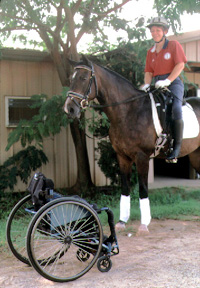Training Tips for
Disabled Riders
U.S. Paralympic team
member Lynn Seidemann gives her training advice to disabled
riders and their instructors.
By Patricia Lasko
| |
 |
| |
Lynn Seidemann and
Hershey © Patricia Lasko/Dressage Today |
- Keep yourself as physically fit as
possible. This will help you to imitate able-bodied riders
more easily. You need to sit straight, for example. I have
feeling from my belly button up, so I try to get the most
out of what I've got. The better I sit straight, the better
my horse goes because less weight is on his back, and I am
able to push him more forward.
- Develop a good position. Just like the
able-bodied riders, you just have to start with right
position. Then everything comes easier.
- Keep your extra equipment as simple as
possible. The best equipment helps you stay steady on the
horse and also is useable on other saddles. One thing that
really helps me--and is particularly good for
paraplegics--is a surcingle with two hand grips that I can
put around any saddle that fits my horse.
Avoid chaffing. Any rider can get sores
from rubbing against the saddle. Try to get the most
comfortable saddle you can--one that fits the horse and you.
Good equipment for special-needs riders is not a luxury. I
use a Wintec saddle because it is light to handle.
- Don't be afraid of the horse going
faster. In therapeutic riding, I was always at a slow pace.
To become a competitive rider I had to learn how to push my
horse more forward and create impulsion. To get a horse's
back to come up under you requires more movement from him.
When the back comes up, it is more comfortable, you sit
better and you stop bouncing. Before, I never wanted to let
my horse's head go because I was afraid he would take off at
the canter. Now I am not afraid because, if he takes off in
the canter, it means we got even more impulsion.
- Feel what the horse is doing. Begin to
develop feel and a good seat by sitting just on a blanket
over the horse's back so you can feel his motion. Then move
to a saddle with a surcingle or whatever you need.
- The best horse to learn on is one with a
quiet, forgiving temperament and a wide barrel, which helps
you to balance in the center of the horse.
- Begin riding at a good therapy barn if
you've never ridden before. It's great to be outdoors doing
your therapy. If you know horses already and rode before you
became disabled, you might not need to start at a therapy
barn. Try a regular barn instead and ask them to assist you.
- To be competitive, disabled riders--like
able-bodied riders--need sponsorship. It would be nice to
have sponsors for disabled riders, too. They have all the
same exact issues as the able-bodied riders, including
finances.
- Find the right instructor. If the first
person doesn't work out, keep looking. Keep following
though. Be persistent.
- You have to find the right horse,
especially when you're just getting started. You can't start
off with a 5-year-old. I think the horse has made a big
difference in the way I have progressed.
- Enjoy your time on top of the horse. I
now can go on trail rides and not worry. It's like I have
four legs when I'm walking through the woods. That's just
incredible. For me to go walking through the woods or
through the pasture is the biggest deal. I couldn't have
done that without a horse.
|
|

|
![]()
![]()
![]()
![]()
![]()
![]()

![]()
![]()
![]()
![]()
![]()
![]()
![]()
![]()




